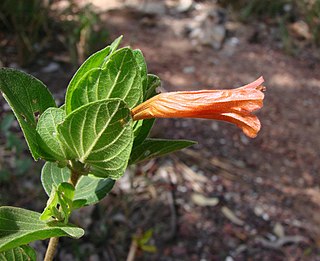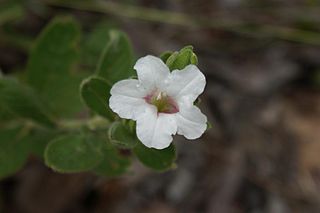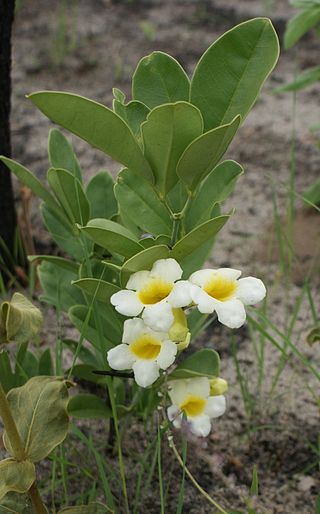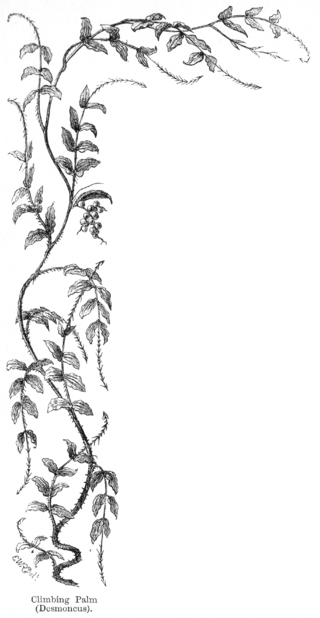
Carl Friedrich Philipp von Martius was a German botanist and explorer. Between 1817 and 1820, he travelled 10,000 km through Brazil while collecting botanical specimens. His most important work was a comprehensive flora of Brazil, Flora Brasiliensis, which he initiated in 1840 and was completed posthumously in 1906.
Gonatogyne is a genus of plants in the family Phyllanthaceae first described as a genus in 1873. It contains only one known species, Gonatogyne brasiliensis, endemic to southeastern Brazil. It is dioecious, with male and female flowers on separate plants.

Flora Brasiliensis is a book published between 1840 and 1906 by the editors Carl Friedrich Philipp von Martius, August Wilhelm Eichler, Ignatz Urban and many others. It contains taxonomic treatments of 22,767 species, mostly Brazilian angiosperms.
Ruellia verbasciformis is a species of flowering plant native to the Cerrado vegetation of Brazil. It is endemic to west-central Brazil. This plant is cited in Flora Brasiliensis by Carl Friedrich Philipp von Martius.
Lepidagathis montana is a species of plant in the acanthus family, Acanthaceae. It is native to central Brazil, including the Espinhaço Range of Minas Gerais state northward to the Chapada Diamantina of Bahia state, and in the Federal District, Goias, and southern Maranhão. It grows in gallery forest and cerrado (savanna) in the southern part of its range. In the northern part of its range in Bahia state it grows in campo rupestre and scrubland.
Lepidagathis sessilifolia is a plant native to the Cerrado vegetation of Brazil and Bolivia. This plant is cited in Flora Brasiliensis by Carl Friedrich Philipp von Martius.

Ruellia villosa is a species of flowering plant native to the Cerrado ecoregion of central and eastern Brazil. This plant is cited in Flora Brasiliensis by Carl Friedrich Philipp von Martius.

Ruellia nitens is a species of flowering plant native to the Cerrado vegetation of central and northeastern Brazil. This plant is cited in Flora Brasiliensis by Carl Friedrich Philipp von Martius.
Aphelandra stephanophysa is a plant species in the family Acanthaceae, which is native to Atlantic Forest vegetation of Brazil. This plant is cited in Flora Brasiliensis by Carl Friedrich Philipp von Martius.
Allamanda puberula is a species of plant in the family Apocynaceae, which is native to Brazil, typically in Caatinga, and Cerrado vegetation. This plant is cited in Flora Brasiliensis by Carl Friedrich Philipp von Martius.

Allamanda angustifolia is a species of plant in the genus Allamanda in the family Apocynaceae, which is found in Brazil, typically in Cerrado vegetation. This plant is cited in Flora Brasiliensis by Carl Friedrich Philipp von Martius. Known in English as alamander, it has been widely cultivated and naturalized in Florida and elsewhere in the United States.

Aechmea pineliana is a flowering plant in the family Bromeliaceae. It is typical of Atlantic Forest vegetation in Brazil, specially in following states: Espírito Santo, Minas Gerais, and Rio de Janeiro. This plant is cited in Flora Brasiliensis by Carl Friedrich Philipp von Martius, and it is often used as an ornamental plant.

Anemopaegma glaucum is a plant native to Caatinga and Cerrado vegetation in Brazil. This plant is cited in Flora Brasiliensis by Carl Friedrich Philipp von Martius.

Desmoncus is a genus of mostly climbing, spiny palms native to the Neotropics. The genus extends from Mexico in the north to Brazil and Bolivia in the south, with two species present in the southeastern Caribbean.

Aegiphila lhotskiana is a species of flowering plant in the family Lamiaceae. It is native to South America, where it occurs in Bolivia and Brazil. This species is cited in Flora Brasiliensis by Carl Friedrich Philipp von Martius.

Zizaniopsis is a genus of plants in the grass family, Poaceae, native to North and South America.
Lomatozona is a genus of Brazilian flowering plants in the tribe Eupatorieae within the family Asteraceae.
Proteopsis is a genus of flowering plants in the family Asteraceae. It is native to Brazil.

Wunderlichia mirabilis is a plant species endemic to the highlands of east-central Brazil. It is known from the states of Espírito Santo, Minas Gerais, Goias, and São Paulo.
Eremitis is a genus of bamboo plants in the grass family, that is endemic to Brazil.










